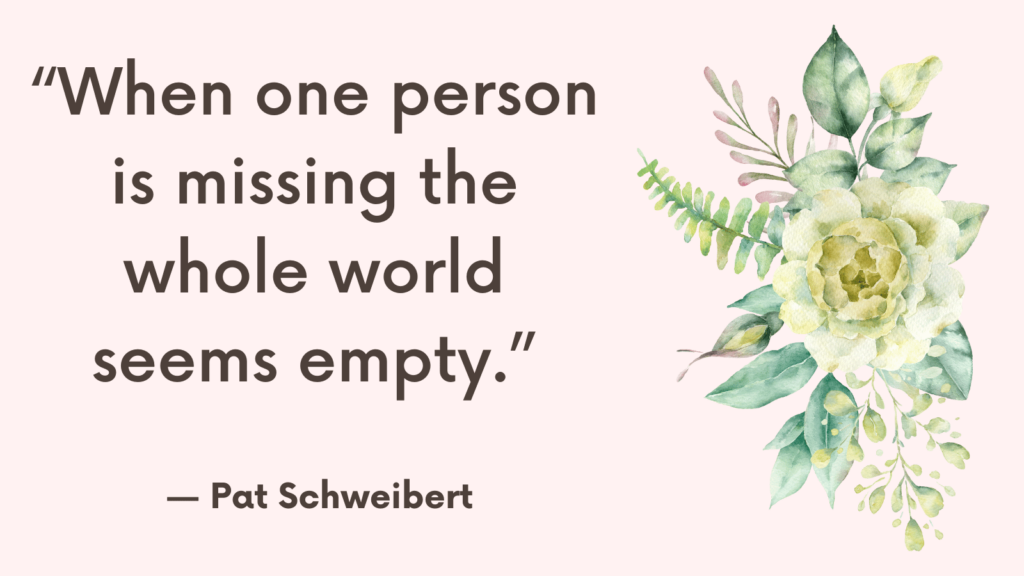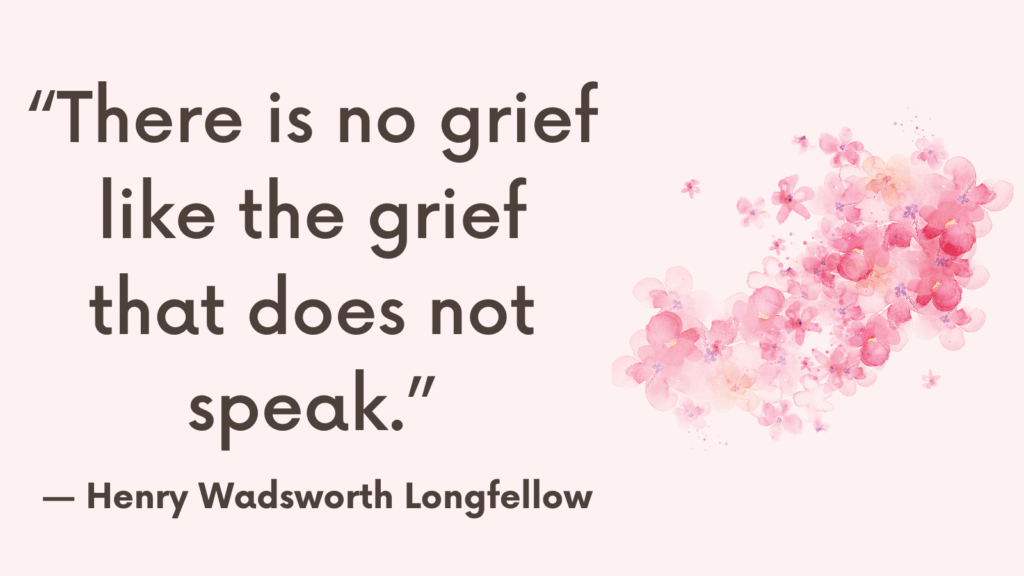In this post, you’ll discover the 6 stages of grief along with helpful tips to help you navigate your grief.
What Does Grief Feel Like?
Grief is a natural response to loss, and it can feel different for everyone.
Some common feelings associated with grief include sadness, anger, confusion, guilt, disbelief, and numbness.
You may also feel physical symptoms like fatigue, loss of appetite, difficulty sleeping, or physical pain.
Grief can be overwhelming and intense, but it’s a normal and healthy process that allows us to heal and eventually find meaning in our loss.
Related: Grief Comes In Waves: Top 12 Lessons From Grief No One Talks About
What Are The 6 Stages of Grief?
Psychiatrist Elisabeth Kubler-Ross developed the stages of grief in her 1969 book “On Death and Dying.”
She based her work on her experience working with terminally ill patients, observing their emotional experiences and responses to the end of life.
Through her observations, she identified five stages of grief: denial, anger, bargaining, depression, and acceptance.
Her work has been widely recognized as a guide to help individuals navigate the grieving process and has been expanded to include more stages.
The 6th stage of grief is often referred to as the stage of reconstruction or reorganization.
Stage 1: Denial
Denial is a normal part of the grief process where an individual is struggling to accept the reality of their loss.
They may feel numb, in shock or disbelief about what has happened. It is common for people to say something like “this isn’t happening” or “it can’t be true”.
It is important to remember that denial is a natural response to grief and everyone experiences it differently.
Stage 2: Anger
Anger is a normal and natural emotion to feel during this time.
You may feel angry towards the situation or towards yourself or others who were involved.
You may also feel frustrated with how you are handling your own emotions.
It could also stem from feelings of powerlessness or helplessness in the face of the loss.
It’s important to remember that feeling angry during grief is normal and
Related: Top 14 CBT Exercise For Anger Management (+FREE Anger Worksheets)
Stage 3: Bargaining
During this stage, it is common to feel a sense of helplessness and a desire to regain control.
This often leads to thoughts of “what if” scenarios and attempts to negotiate with a higher power or fate.
Stage 4: Depression
Feeling depressed during the grieving process is common, as depression is a natural part of the grieving process.
You may find yourself feeling sad, lonely, or even hopeless during this stage.
You may also lose interest in life or experience changes in appetite and sleep patterns.
These feelings are typically temporary, but they can be intense and overwhelming at times.
Related: Top 10 Gratitude Exercises To Practice Even When Depressed
Stage 5: Acceptance
During the process of grieving, acceptance is the stage where individuals come to terms with the reality of their loss.
Acceptance does not mean that they no longer feel the pain or sadness associated with their loss, but rather it is the start of a healing process where they begin to find ways to cope and move forward.
Stage 6. Reconstruction
In this stage, the individual begins to find ways to rebuild their life and move on from the loss they have experienced.
They may start to find new interests, hobbies, or relationships that help them create a new sense of purpose and meaning.
Note that not everyone will go through this stage, and the grieving process is not always linear or predictable.
Related: Best +30 Grief Activities For Adults (+FREE Worksheets PDF)
How To Cope With the 6 Grief Stages?
#1. Coping with Denial
1. Acknowledge your denial: The first step is to recognize that you are in denial. Denial can make it difficult to accept the truth and move forward. It’s important to acknowledge your denial in order to begin the healing process.
2. Seek support: Talk to someone you trust, whether it’s a friend, family member or therapist. You may also write in your journal. Going through what happened can help you come out of denial sooner and begin healing.
3. Practice self-care: Give yourself permission to take a break from responsibilities or social situations if needed.
#2. Managing Anger
1. Acknowledge and accept your feelings: It’s important to acknowledge your anger and allow yourself to feel it. Don’t bottle up your emotions, as this can lead to further frustration and resentment.
2. Identify the trigger: Try to identify what is causing your anger. Is it a certain person, situation or memory? Once you know the trigger, you can work on addressing it.
3. Find healthy ways to express your anger: Instead of lashing out at others or bottling up your anger, find healthy ways to express it. This could include exercise, writing in a journal, or talking to a trusted friend or therapist.
Related: How To Help A Grieving Parent? (+FREE Worksheets For Grief)
#3. Dealing with Bargaining
Bargaining is a way to cope with the pain even though you may acknowledge that it’s not possible to change the reality of the loss.
Be gentle and patient with yourself during this time.
Allow yourself to feel your emotions and express your thoughts without judgment.
You may find comfort in talking with others who have gone through similar experiences.
Related: Resilient Grieving: Best 17 Ways To Manage Grief In The Workplace (+FREE Grief Worksheets)
#4. Coping with Depression
1. Allow yourself to grieve: Allow yourself to cry and be sad.
2. Take care of yourself: Focus on the basics as you may not have energy to do a lot. Try to eat healthy foods, do some exercises, and get enough sleep.
3. Set small goals: Setting small goals for yourself can help you feel like you’re making progress. It could be something as simple as taking a walk around the block or spending time with friends.
5. Be patient with yourself: Grieving is a process and there is no set timeline for how long it will take. Be patient with yourself and don’t put pressure on yourself to “get over it” or move on too quickly.
Related: Grieving Someone Who Is Still Alive – Ambiguous Grief
#5. Reaching Acceptance
Take time to reflect on the good memories and experiences you shared with the person or thing you have lost.
Celebrate the positive influence they had on your life.
Doing this can help you move towards acceptance, and provide comfort when you’re feeling down.
Remember that the stages of grief are not necessarily experienced in a linear, step-by-step process.
Related: Cumulative Grief: How To Cope With Bereavement Overload?
#6. Beginning Reconstruction
1. Find meaning in your loss: Try to reflect on what you’ve gained and how you can honor the memory of the person or thing you’ve lost.
2. Look for ways to give back: Look for ways to give back to your community or volunteer with organizations that align with your values. Helping others can be healing and rewarding.
3. Discovering new passions: Losing someone can force us to re-examine our priorities and goals. It can also create space for new experiences and opportunities. Some people use this time to try new things, explore new hobbies or pursue new interests.
Related: Top 35 Grief Affirmations (+FREE Grief Worksheets)

Conclusion
It’s also important to be patient with yourself and allow yourself the time and space you need to grieve in your own way.
Grief is a unique and personal experience, and there’s no right or wrong way to feel or cope with it.
Related: Grief Resources (FREE Worksheets, APPS, Podcasts, TED Talks, Books)
FAQ
How long does grief last?
There is no set timeframe for grief, as it is a highly individualized process.
The duration of grief can be influenced by factors such as the nature of the loss, an individual’s coping mechanisms, their support system, and their previous experiences with loss.
Grief is not something that can be rushed or forced to be over within a specific time frame.
What are the common symptoms of grief?
Grief can manifest differently for each person, but some common symptoms include sadness, difficulty concentrating, changes in appetite or sleep patterns, irritability, social withdrawal, guilt, anger, and longing for the person or thing that was lost.
Physical symptoms such as fatigue or stomachaches may also occur.
Is it normal to feel a wide range of emotions during grief?
Absolutely. Grief is often characterized by a rollercoaster of emotions.
People may experience sadness, anger, guilt, confusion, relief, numbness, or even moments of happiness as they reminisce about their loved one or come to terms with their loss.
It’s important to remember that all these emotions are valid and part of the grieving process.
When should I seek professional help for my grief?
It is advisable to reach out to a mental health professional if your grief is significantly impacting your daily functioning, relationships, or overall well-being.
If you’re experiencing intense or prolonged feelings of hopelessness, suicidal thoughts, or if you’re unable to perform essential tasks, seeking professional help can provide the necessary support.



